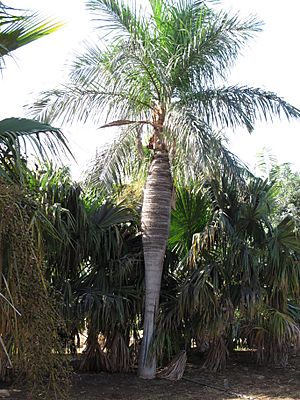Cuban belly palm facts for kids
Quick facts for kids Cuban belly palm |
|
|---|---|
 |
|
| Scientific classification | |
| Genus: |
Acrocomia
|
| Species: |
crispa
|
| Synonyms | |
|
Acrocomia armentalis (Morales) L.H. Bailey |
|
The Cuban belly palm (also known as Acrocomia crispa or corojo) is a special type of palm tree. It only grows in Cuba, which means it's native to that island. This palm gets its unique name because its trunk is thin at the bottom, but then it swells out in the middle, looking a bit like a belly! It's also a tall and spiny tree. Scientists used to think it belonged to its own group of palms called Gastrococos, but now they know it's part of the Acrocomia family.
What Does It Look Like?
The Cuban belly palm grows from a single stem. It can reach heights of about 7 to 18 meters (23 to 59 feet). Its trunk has a clear "spindle-shaped" bulge in the middle, which is why it's called the "belly palm." When the tree is young, its trunk is covered in many spines. But as the palm gets older, these spines fall off, and the trunk becomes smooth and grey.
Each palm tree has about 10 to 20 large leaves. These leaves can grow up to 3 meters (10 feet) long. They are pinnately-compound, which means they have many small leaflets arranged like a feather along a central stem. The leaflets usually grow almost directly opposite each other.
How It Got Its Name
The Cuban belly palm has had a few different scientific names over time. The first time it was described was in 1816 by a scientist named Carl Sigismund Kunth. He called it Cocos crispa. He based his description on a palm sample collected by famous explorers Alexander von Humboldt and Aimé Bonpland.
Later, in 1866, another scientist named Sebastián Alfredo de Morales described a similar palm and called it Gastrococcus armentalis. He thought it was a different species. But in 1912, based on new information, Odoardo Beccari officially named it Acrocomia crispa. This is the name scientists use today, showing it's part of the Acrocomia group of palms.
See also
 In Spanish: Acrocomia crispa para niños
In Spanish: Acrocomia crispa para niños

